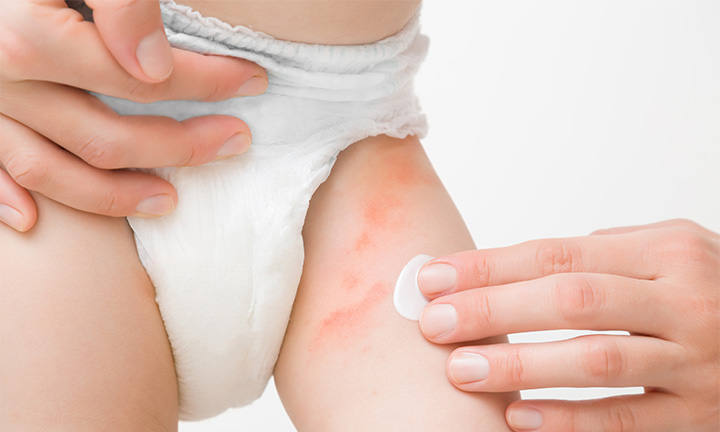
Essential Tips To Prevent Diaper Rash In Babies
Diaper rash, diaper eczema, diaper dermatitis: a troublesome rash on a baby’s bottom. It afflicts 35-40% of children between the ages of 9 and 12 months. But what exactly is it? How does it appear? And how is diaper rash treated? Here are some tips to help!
What Is Diaper Rash?
When a baby gets diaper rash, the skin around the buttocks and thighs becomes inflamed. The skin is red and cracked. Sometimes blisters and scars form. The rash is not dangerous, but it can be very bothersome to your child, which may cause him or her to cry a lot.
How Does Diaper Rash Develop?
Diaper rash or eczema is caused by wearing diapers. The baby’s urine and stools contain substances that affect the skin’s pH level. The added friction between the diaper and skin creates a warm, moist, suffocating environment. The skin then becomes sensitive and more irritated.
These other factors can also cause diaper rash:
- Not cleaning the skin properly
- Infrequent diaper changes
- The child has diarrhea
- Child is prone to eczema
- Antibiotics treatment
- Fungal infection- This is a persistent form of diaper rash. Fungal infections often present as red bumps or blisters with white pus. If a fungal infection is suspected, contact a physician immediately.
- It is also believed that there is a relationship between diaper rash and teething, but this has never been scientifically proven.
Diaper Rash Treatment and Prevention: 6 Key Points
Diaper rash can be successfully treated by following these:
- Change diapers frequently: change diapers at least 8 times a day. Change diapers as soon as you notice that they are dirty. Babies should not wear hot, stuffy diapers for long periods as this may irritate the skin.
- Keep baby’s bottom clean: Wash baby’s bottom often. Work gently but thoroughly.
- Use appropriate water and wet wipes: use warm water or pH-neutral, unscented wet wipes for cleaning and dry throuroughly.
- Apply zinc ointment: A thin layer of zinc ointment or zinc oil can be applied to protect the skin from moisture and also provide a disinfectant effect. Sudocrem is a commonly used cream that works well. It contains zinc as well as emollient oils.
- Do not over-tighten: not over-tightening allows air to circulate in the diaper.
- Use diapers with more absorbent material: Diapers with more absorbent material reduce the warm, moist environment inside the diaper.

Other Natural Remedies For Diaper Rash
Cornstarch
Cornstarch can be used immediately after washing the baby’s private parts with water only and then drying them lightly to prevent the skin and diaper from sticking too tightly together and tearing further. It is also a good substitute for talc in the prevention phase.
Use Coconut Oil
Coconut oil has a cooling effect on the skin, which can improve and prevent diaper rash in babies. Apply it liberally around the diaper area each time you change your baby’s diaper to reduce tingling and protect the skin.
Use Ecological Diapers
The use of disposable diapers causes frequent irritation in the area because of the 24-hour contact with the child. The situation is made worse because many of the materials are not suitable for children, and also because of the heat buildup in the lower part of the body. Try using ecological diapers made of more natural and less irritating substances.
Visit The Doctor
It is usually not necessary to go to a doctor for diaper rash. However, if the rash does not disappear after a week, or if it gets worse, the best thing to do is to visit the doctor. It may require some minor treatment, such as applying a special cream. Your baby may also develop a fungal or Candida infection. In this case, specific treatment is needed.

Let us know if these few tips have helped you in the comments below!
You May Also Like

Why Introducing Your Kids to Gymnastics Is A Fantastic Idea
2023-01-19
Is Your Child Thriving in the Right School Environment?
2024-04-24

